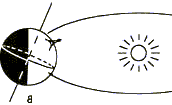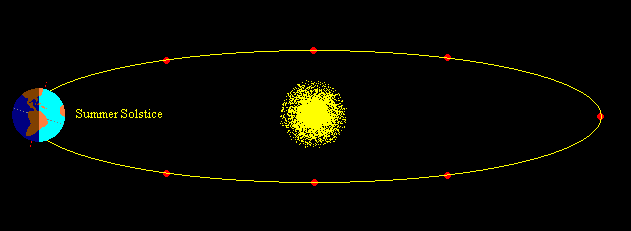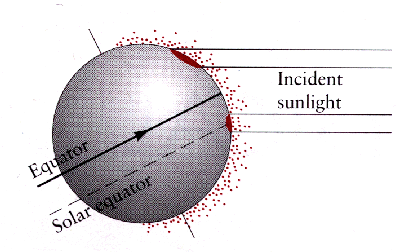See the earth spinning? This is what causes us to have night and day. The earth spins on it's axis but not quite as fast as this one is spinning. We call this spinning rotating. It take the earth 24 hours (actually 23 hours 56 minutes and 4.09 seconds) to rotate once around. In other words it rotates once per day. The axis of rotation is an imaginary line between the north and south poles. Now, this axis is tilted. It doesn't go straight up and down - it is on an angle. The angle is 23.5 .
The Earth is rotating slowly (over 1600 km / hr. which is slow in space) all of the time. We don't feel anything because it turns at the same speed and it is very smooth. Another reason we don't feel any movement is because everything is moving and all at the same time. If you look closely at this next diagram you can 1) see the tilt of the earth on its axis, 2) see the sun in the centre and 3) see how the light of the sun is shining on exactly 1/2 of the earth. This half, the half facing the sun is in daytime. The back half is in a shadow or darkness so it would be night time. The Sun can only shine on half the Earth at any time. The half that the Sun is shining on is day time. The half that is facing away from the Sun is night time. As the earth makes its rotation the area having daylight will slowly turn into dusk then evening while the area that was having night will begin to experience dawn and then full daylight. There you have it Night and Day! One other piece of information for you. The Earth is always rotating or spinning eastward.
The tilt of the earth's axis while it revolves around the sun creates our seasons.
The Earth’s axis is always tipped or slanted in the same direction This means that sometimes the northern half of the Earth is tipped towards the Sun (summer), and sometimes it is slanted away (winter).
We experience seasons because the earth is tilted 23.5°. As the earth revolves around the sun, different parts of the earth are tilted towards the sun. When the northern hemisphere is slanted towards the sun, it is getting more direct sunlight. It will be summer in the northern hemisphere. Canada will have the sun almost directly overhead so that the sun’s rays will be quite concentrated causing temperatures to be warm. If you look at the diagram above and to the right, you will see that the southern hemisphere is tilted away from the sun. This means that the sun’s rays will strike the earth on an angle causing the heat to spread out which results in much colder temperatures. The southern hemisphere would be having winter.
The summer solestice (first day of summer) is June 21. This is the longest day of the year, meaning, that we get the greatest number of daylight hours. At this time, the sun's direct rays are striking right on the Tropic of Cancer.
Exactly 6 months later is the winter solstice (Dec. 21/22), our shortest day. Here the sun's direct rays are now striking the Tropic of Capricorn which is in the southern hemisphere. Between these two times are the equinoxes. The first day of spring and the first day of fall ( March 21/22 and Sept. 21/22 ). At these times, the direct rays are striking the equator.
It take the earth 365.25 or 365 1/4 days to revolve once around the sun which is our year. We can't use 1/4 of a day, so these 1/4 days are saved up until we get 4 of them. Four 1/4's makes one more full day. This full extra day is given to Feb. Now you know how and why we have Leap Year.
Check out the two poles. Sometimes they get sunlight ALL the time.
Sometimes it is dark ALL the time.
Introduction
Solar System
The Sun
Meteors, Asteroids, Comets,
Satillites and Planets






